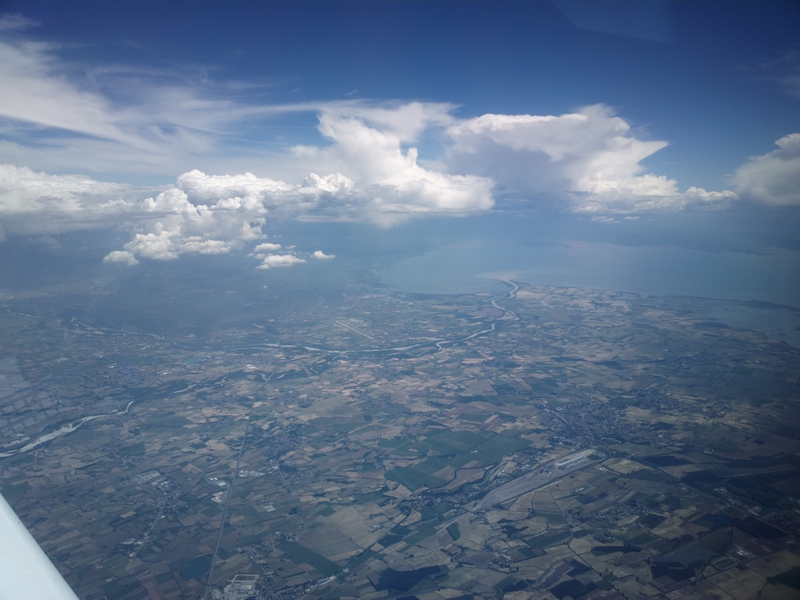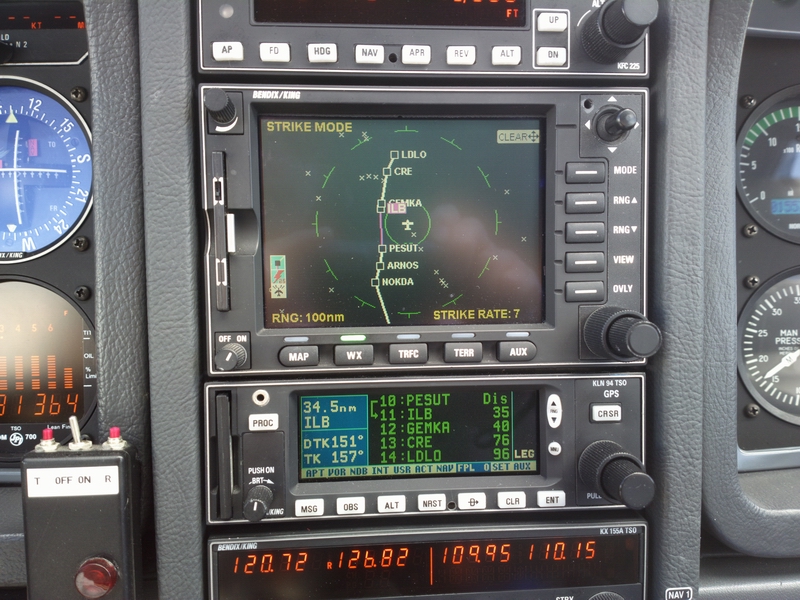I have been flying with the WX500 for 11 years. It quite obviously works in that it picks up strikes but it is equally obvious from flying in VMC that some big nasty and presumably very turbulent stuff produces no strikes at all, and some small bits of white fluff do produce a strike or two.
For example this stuff

could be relied on to show up like this

To get a proper cluster of strikes you need a really massive CB.
As a result I would not use the stormscope for avoidance of seriously convective weather during a prolonged flight in IMC. I suppose it could be useful in an unusual situation where a lot has gone wrong and you find yourself in IMC with convective weather around, which you might then fly into. That hasn’t happened to me yet, but the relatively small cost and negligible weight of a stormscope puts it in the “may as well have it” category.
The Q is whether Avidyne’s box does something worth having.
In fact I wonder if they even make it. The TCAS products were bought in from Ryan.
The TWX probably can’t display on my KMD550 MFD (I can’t find a clear data sheet on the Avidyne website right now) but I would be changing that anyway, possibly to an EX600.
It’s based on the same principle and will show the same results.
Of the four tactical avoidance means I have in the plane,the MkI eyeball outperforms the others, Downlink weather is a solid number two, while onboard radar and storm scope come as a mixed blessing; storm scope seems to me useful as a long range, area-wide waning system. Radar is a very tricky piece of equipment to operate.
BTW, I’m now a bit more experienced with the Ex600, and it suffers from a “freeze” problem probably linked to a lack of onboard memory: in a long flight where I download a lot of weather and then use the radar, the unit will stay stuck in radar mode and not offer the possibility to return to Map or Trip without restarting the unit (which is thankfully quite fast to do and with fpl crossfill from the GTN doesn’t mean entering anything again). The previous owner paid $600 to increase the memory but this hasn’t solved the issue.
Peter, answers to your questions are on slides 50 and beyond of this presentation.
[http://www.avidyne.com/downloads/media/corporate-webinars/Corporate_Weather.pdf](http://www.avidyne.com/downloads/media/corporate-webinars/Corporate_Weather.pdf)
Basically, Ryan is making it. The TWX670 is able to detect <25nm distant strikes and it has higher accuracy and giving less false returns than a WX500. And I read somewhere that the TWX670 can use the RS232 WX500 protocol. But you will be in compatibility mode, so I would expect that the features will be degraded to the level of a WX500.
One thing I do not fully understand is how this class of devices can detect the range and intensity of the strikes. To my understanding they measure the electric discharge. Then they use the signal strength to guess the distance. This method will obviously not work very well if strikes are not of nominal intensity. But the Avidyne publication suggests they can tell distance and intensity apart. How so they do it?
When detecting strikes from the ground they are usually measured from different locations with a precise clock. Then the location of the strike can be triangulated from the time shift and the intensity of the signal corrected by the distance gives the strike intensity. But that is not possible from the plane with just one receiver.
>One thing I do not fully understand is how this class of devices can detect the range and intensity of the strikes. To my understanding they measure the electric discharge. Then they use the signal strength to guess the distance. This method will obviously not work very well if strikes are not of nominal intensity. But the Avidyne publication suggests they can tell distance and intensity apart. How so they do it?
I vaguely recall reading somewhere that they use the spectrum of the received signal, which somehow changes a little with the distance. There are some patents in that area, which have unfortunately prevented a number of other people entering the market, reportedly.
However I know the reported distance can be out by a factor of 2×. In reality this doesn’t matter all that much.
Many thanks for the PDF – I will read it tomorrow morning (been a long day…).
And yes the WX500 will display the data but without colour coding or similar stuff, apparently.
Re false returns – I get them from radar, especially aircraft radar if very close (usually from parked and taxiing turboprops and jets). But they are very obvious – long stripes of strikes.
Many thanks for that PDF, ploucandco. Just read through it.
It seems to me that after one has removed the hyperbole like “Provides true Tactical Weather Detection” the main thing they claim over the WX500 is that they display strikes within 25nm, whereas (they claim) the WX500 does not show such strikes.
I can’t see how a WX500 would not display such strikes. For a start, as Sebastian points out, you can’t really tell the distance directly. But I have flown much closer than 25nm to a striking cloud and it did show strikes. What I can’t recall is the distance it showed them at. But I am fairly sure I have seen strikes displayed very close.
I agree the Mk I eyeball is far superior than any gizmos, except when you are buried in IMC.
I consider the stormscope purely a long range strategic tool as a backup to other observations, and I treat the weather radar as a close up tactical tool for avoidance.
No chance of Nextrad in these parts.
Investing the time in correct weather radar operation and interpretation is very worthwhile. When operated correctly it is an immensely versatile and powerful tool. Archie Tremell has an excellent course dedicated to it.
I use mine extensively, and I treat it as a MEL item when launching into IMC conditions.
E
Coming back today from France, flew over some stuff in the Channel that showed activity on the stormscope and the downlink weather, but nothing at all on the radar.
Then the “antenna fail” indication appeared on the ex600.
Now I’m wondering if the uselessness of radar in my experience over the last 5 months of ownership wasn’t simply due to faulty equipment :-(
Peter I am surprised that on the picture you show only limited returns where captured.
On my previous aircraft it had a WX11 and you could even see returns from cumulus clouds which where developing into fast growing towering ones.. I prefer a separate display as you can monitor better the strike spread…
The Avydine system works the best with the expensive dedicated separate display( MHD300), in connection with an MFD or SN3500 I think there is no major improvement you loose some information even…
My experience with it flying into summer convective southern Europe is that it gives you a good idea where the real convective weather is long distance…Once to close (or really in it) it doesn’t help much as the dot’s are everywhere….
I once flew through some real severe weather with a Pilot friend three years ago it was quite a nerving experience having the stormscope helped for sure to avoid the worst.
I am really hoping for an affordable SAT solution for Europe together with storm-scope this would be a great help….
I believe (from what I have read) the WX950 and WX1000 are best stormscopes around…
Now I have a WX1000E (shows the flight plan from the KLN90B) the previous owner loved it….we shall see how it performs in the coming months…….
> Now I’m wondering if the uselessness of radar in my experience over the last 5 months of ownership wasn’t simply due to faulty equipment :-(
Did it show ground returns? If I tilt our radar down I can see all kind of stuff like coast lines, big industrial buildings etc.
> I am really hoping for an affordable SAT solution for Europe
I manufacture the ADL110 and ADL120. Sjoerd which is also on this forum is also working on a solution. Datalink strikes are way ahead of on board detected strikes but then you have to have the equipment, pay for transmission and it will not work worldwide as the on board equipment.
Personally I fly with on board radar, datalink and the WX500. The WX500 is the least usefull comparmed to the other equipment. Ours will not display correctly the range and bearing. Bascially it will tell me there are thunderstorms somewhere around but not much more.